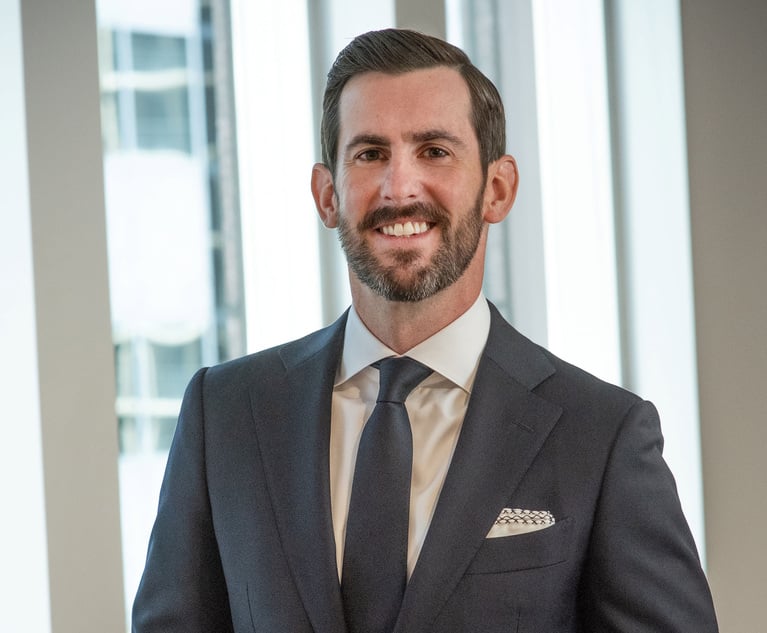Second Circuit Provides Helpful Guidance for Rebutting Price Impact
Earlier this year, a panel of the U. S. Court of Appeals for the Second Circuit issued an opinion in the securities fraud action, Arkansas Teachers Retirement System v. Goldman Sachs Group, 879 F.3d 474 (2d. Cir. 2018), that provides district courts with long-overdue guidance for assessing a defendant's rebuttal evidence at the class certification stage.
March 14, 2018 at 01:42 PM
10 minute read

Earlier this year, a panel of the U.S. Court of Appeals for the Second Circuit issued an opinion in the securities fraud action Arkansas Teachers Retirement System v. Goldman Sachs Group, 879 F.3d 474 (2d. Cir. 2018), that provides district courts with long-overdue guidance for assessing a defendant's rebuttal evidence at the class certification stage.
Although the U.S. Supreme Court held in its seminal opinion, Halliburton v. Erica P. John Fund (Halliburton II), 134 S. Ct. 2398 (2014), that a defendant may rebut the fraud-on-the-market presumption of reliance permitted under Basic v. Levinson, 485 U.S. 224 (1988), with evidence that the alleged misrepresentations did not impact the company's stock price, Halliburton II does not provide clear standards for assessing a defendant's rebuttal evidence. Consequently, many lower courts, including the U.S. District Court for the Southern District of New York in Goldman, have been reluctant to fully consider a defendant's evidence of lack of price impact. (See In re Goldman Sachs Group Securities Litigation, Master File No. 10 Civ. 3461, 2015 U.S. Dist. LEXIS 128856, at *17-22 (S.D.N.Y. Sept. 24, 2015) (certifying class after declining to consider the defendants' lack of price impact evidence).)
In its decision vacating the Southern District's class certification order in Goldman, the Second Circuit delineated two requirements for evaluating a defendant's rebuttal evidence that, according to the court, are consistent with the Supreme Court's decisions in Basic and Halliburton II.
First, the court reiterated a recent holding by another Second Circuit panel in Waggoner v. Barclays, 875 F.3d 79, 101-103 (2d Cir. 2017), that “defendants in a securities fraud class action bear the burden of persuasion to rebut the Basic presumption, and that they must do so by a preponderance of the evidence,” Goldman, 879 F.3d at 484. Accordingly, the court held that the Southern District committed error when it apparently imposed a higher “conclusive evidence” standard to the Goldman defendants' rebuttal evidence.
Second, the court explained that, in determining whether a defendant has met this burden, district courts must consider the defendant's evidence of an absence of price impact, i.e., that the “'alleged misrepresentation did not, for whatever reason, actually affect the market price.'” Therefore, the court held, the Southern District erred when it declined to consider the Goldman defendants' evidence of lack of price impact.
Because Halliburton II did not provide district courts with clear guidance for how to assess a defendants' rebuttal evidence, defendants in securities litigation—even where price impact is at issue—have faced an uphill battle when attempting to defeat class certification. Instead of seeking appellate review, which can be viewed as futile given the lack of clear standards, they often opt to settle. Now defendants with viable evidence of no price impact can arm themselves with the Second Circuit's decision in Goldman that, if followed, requires district courts to consider a defendant's rebuttal evidence.
Rebutting Price Impact: Background
To bring a securities fraud lawsuit under Section 10(b) of the Securities Exchange Act of 1934 and the U.S. Securities and Exchange Commission Rule 10b-5, an investor plaintiff must prove, among other things, that he or she individually relied on the alleged misrepresentation. If courts strictly applied this requirement in the class action context, then common questions would not “predominate” for purposes of satisfying Federal Rule of Civil Procedure Rule 23(b)(3). Instead, each investor would have to testify that he or she was aware of the alleged misrepresentation and made an investment decision based on that representation.
In Basic, the Supreme Court addressed this issue by holding that prospective investor classes could use a proxy for individual reliance by establishing a rebuttable presumption of class-wide reliance via the fraud-on-the-market theory. Under this theory, as long as a company's stock trades in an efficient market, all public information about that stock is viewed as being incorporated in the stock's price—including the alleged misrepresentation. Thus, a court may presume that all members of the putative class indirectly relied on the alleged misrepresentation through reliance on the stock's market price, so long as the plaintiffs can prove an efficient market, see Basic, 485 U.S. at 246-249.
In Halliburton II, Halliburton asked the court to allow a corporate defendant to rebut the Basic presumption and prevent class certification by introducing evidence that the alleged misrepresentations did not impact the market price of its stock. The court agreed with Halliburton that, if a plaintiff establishes the Basic presumption, then the defendant “should at least be allowed to defeat the presumption at the class certification stage through evidence that the misrepresentation did not in fact affect the stock price.”
The District Court's Rejection
In their complaint against the Goldman Sachs Group Inc. and several of its directors (collectively, the defendants), the plaintiffs, who purchased Goldman stock between Feb. 5, 2007, and June 10, 2010, alleged that the defendants made material misrepresentations during this putative class period about Goldman's efforts to avoid conflicts of interest in violation of Section 10(b) and Rule 10b-5.
According to the complaint, Goldman's statements about these efforts were false and misleading because Goldman allegedly acted in direct conflict with its clients' interests in at least four collateralized debt obligation transactions involving subprime mortgages between 2006 and 2007. The plaintiffs further claimed that news reports of government enforcement actions against Goldman on April 16, 2010, April 30, 2010, and June 10, 2010, revealed the alleged falsity of the company's statements and caused a decline in its stock price.
In their opposition to the plaintiffs' motion for class certification, the Goldman defendants attempted to rebut the Basic presumption with evidence showing that Goldman's stock price did not increase on the dates the alleged misrepresentations were made and did not decrease on 34 occasions before 2010 when the press reported Goldman's purported conflicts of interests. Accordingly, the defendants argued, “the misstatements did not affect the price of Goldman stock and plaintiffs could not have relied on them in choosing to buy shares at that price.”
The district court rejected the defendants' argument and certified the class without holding either an evidentiary hearing or oral argument. The court held that the defendants' evidence that Goldman's stock price did not increase on the dates the alleged misstatements were made was “insignificant” in light of the plaintiffs' argument “that the misstatements simply served to maintain an already inflated stock price.”
The court also held that the defendants' argument regarding the lack of a stock price drop on 34 dates prior to April 16, 2010, constituted an “inappropriate truth on the market defense” or an argument for materiality and, therefore, in the court's view, was inappropriate at the class certification stage.
Furthermore, according to the court, the defendants' “attempt to demonstrate a lack of price impact merely marshals evidence which suggests a price decline for an alternate reason, but does not provide conclusive evidence that no link exists between the price decline and the misrepresentation.” Thus, the court held that because the plaintiffs had demonstrated an efficient market and the defendants failed to “demonstrate a complete absence of price impact,” the plaintiffs were entitled to the presumption of reliance under Basic.
The Second Circuit's Remand Instructions
The Second Circuit granted the defendants' Rule 23(f) petition for leave to appeal the Southern District's class certification order and, on Jan. 12, 2018, issued its decision vacating the order and remanding the case back to the district court for further proceedings.
The court's decision, summarized at the beginning of this article, sets forth specific remand instructions. First, the court noted that it was not clear from the district court's opinion whether the lower court applied the proper evidentiary standard—preponderance of the evidence—when assessing the defendants' rebuttal evidence. As the court explained: “Although the district court acknowledged that standard in a footnote in its decision, it went on to find that defendants failed to rebut the Basic presumption because they did not 'conclusively' prove a 'complete absence of price impact,'” Goldman, 879 F.3d at 485 (internal citations omitted). Accordingly, the court instructed the lower court to reconsider the defendants' rebuttal evidence under the preponderance of the evidence standard.
Second, the court held that the district court's rejection of the defendants' lack of price impact evidence on truth-on-the-market and materiality grounds was error and instructed the lower court to consider the evidence on remand. As the court explained:
Contrary to the district court's characterization of their evidence, defendants did not present a “truth on the market” defense. The defendants did not argue, for example, that Goldman's conflicts of interest were already known to the market at the time plaintiffs purchased their shares of Goldman common stock. Indeed, it was undisputed that plaintiffs purchased their shares after the misstatements were made but before the truth was revealed. Rather, the defendants presented evidence that the market learned the truth about Goldman's conflicts of interests in the Abacus, Hudson, Anderson, and Timberwolf transactions on 34 occasions from 2007 to 2009, without any accompanying decline in the price of Goldman stock. The defendants used that evidence to show that their statements about Goldman's efforts to avoid conflicts of interest “did not actually affect the stock's market price.”
As for the district court's conclusion that the defendants' evidence implicated materiality and, therefore, was not appropriately considered at the class certification stage, the court explained that price impact “differs from materiality in a crucial respect.” Quoting Halliburton II, the court distinguished price impact from materiality:
Whether a misrepresentation was reflected in the market price at the time of the transaction —whether it had price impact—“is Basic's fundamental premise. It … has everything to do with the issue of predominance at the class certification stage.” If a defendant shows that an “alleged misrepresentation did not, for whatever reason, actually affect the market price” of the defendant's stock, “there is no grounding for any contention that the investor indirectly relied on that misrepresentation through his reliance on the integrity of the market price”; the fraud-on-the-market theory underlying the presumption would “completely collapse.”
Notably, the Second Circuit did not address the district court's application of a price maintenance theory in rejecting the defendants' evidence that Goldman's stock price did not increase on the dates the alleged misstatements were made. Presumably, the applicability of that theory will be litigated on remand since it seems inconsistent with the lack of stock price movement on the 34 occasions before 2010 when the press reported Goldman's purported conflicts of interests.
Also notable is the Second Circuit's explicit direction to the district court “to hold any evidentiary hearing or oral argument it deems appropriate under the circumstances.” Such instruction is consistent with district courts' obligations under Wal-Mart Stores v. Dukes, 564 U.S. 338, 350-351 (2011), and Comcast v. Behrend, 133 S. Ct. 1426, 1432 (2013), to conduct a “rigorous analysis” when determining whether Rule 23's prerequisites have been satisfied.
Counsel litigating securities class actions should continue to follow this case as the district court's re-analysis of the Goldman defendants' rebuttal evidence on remand, along with any further Second Circuit review, will provide further instruction on how to effectively rebut the Basic presumption at the class certification stage.
Robert L. Hickok is a partner in the commercial litigation practice group of Pepper Hamilton. He can be reached at 215-981-4583 or [email protected].
Gay Parks Rainville is special counsel in the firm's commercial litigation practice group and co-chairs, with Hickok and Los Angeles partner Pamela S. Palmer, the securities and shareholder litigation section of the practice group. She can be reached at 215-981-4952 or [email protected].
This content has been archived. It is available through our partners, LexisNexis® and Bloomberg Law.
To view this content, please continue to their sites.
Not a Lexis Subscriber?
Subscribe Now
Not a Bloomberg Law Subscriber?
Subscribe Now
NOT FOR REPRINT
© 2025 ALM Global, LLC, All Rights Reserved. Request academic re-use from www.copyright.com. All other uses, submit a request to [email protected]. For more information visit Asset & Logo Licensing.
You Might Like
View All
Neighboring States Have Either Passed or Proposed Climate Superfund Laws—Is Pennsylvania Next?
7 minute read
Seven Rules of the Road for Managing Referrals To/From Other Attorneys, Part 2
6 minute read
With New Civil Jury Selection Rule, Litigants Should Carefully Weigh Waiver Risks
6 minute readTrending Stories
- 1Departing Attorneys Sue Their Former Law Firm
- 2Pa. High Court: Concrete Proof Not Needed to Weigh Grounds for Preliminary Injunction Order
- 3'Something Else Is Coming': DOGE Established, but With Limited Scope
- 4Polsinelli Picks Up Corporate Health Care Partner From Greenberg Traurig in LA
- 5Kirkland Lands in Phila., but Rate Pressure May Limit the High-Flying Firm's Growth Prospects
Who Got The Work
J. Brugh Lower of Gibbons has entered an appearance for industrial equipment supplier Devco Corporation in a pending trademark infringement lawsuit. The suit, accusing the defendant of selling knock-off Graco products, was filed Dec. 18 in New Jersey District Court by Rivkin Radler on behalf of Graco Inc. and Graco Minnesota. The case, assigned to U.S. District Judge Zahid N. Quraishi, is 3:24-cv-11294, Graco Inc. et al v. Devco Corporation.
Who Got The Work
Rebecca Maller-Stein and Kent A. Yalowitz of Arnold & Porter Kaye Scholer have entered their appearances for Hanaco Venture Capital and its executives, Lior Prosor and David Frankel, in a pending securities lawsuit. The action, filed on Dec. 24 in New York Southern District Court by Zell, Aron & Co. on behalf of Goldeneye Advisors, accuses the defendants of negligently and fraudulently managing the plaintiff's $1 million investment. The case, assigned to U.S. District Judge Vernon S. Broderick, is 1:24-cv-09918, Goldeneye Advisors, LLC v. Hanaco Venture Capital, Ltd. et al.
Who Got The Work
Attorneys from A&O Shearman has stepped in as defense counsel for Toronto-Dominion Bank and other defendants in a pending securities class action. The suit, filed Dec. 11 in New York Southern District Court by Bleichmar Fonti & Auld, accuses the defendants of concealing the bank's 'pervasive' deficiencies in regards to its compliance with the Bank Secrecy Act and the quality of its anti-money laundering controls. The case, assigned to U.S. District Judge Arun Subramanian, is 1:24-cv-09445, Gonzalez v. The Toronto-Dominion Bank et al.
Who Got The Work
Crown Castle International, a Pennsylvania company providing shared communications infrastructure, has turned to Luke D. Wolf of Gordon Rees Scully Mansukhani to fend off a pending breach-of-contract lawsuit. The court action, filed Nov. 25 in Michigan Eastern District Court by Hooper Hathaway PC on behalf of The Town Residences LLC, accuses Crown Castle of failing to transfer approximately $30,000 in utility payments from T-Mobile in breach of a roof-top lease and assignment agreement. The case, assigned to U.S. District Judge Susan K. Declercq, is 2:24-cv-13131, The Town Residences LLC v. T-Mobile US, Inc. et al.
Who Got The Work
Wilfred P. Coronato and Daniel M. Schwartz of McCarter & English have stepped in as defense counsel to Electrolux Home Products Inc. in a pending product liability lawsuit. The court action, filed Nov. 26 in New York Eastern District Court by Poulos Lopiccolo PC and Nagel Rice LLP on behalf of David Stern, alleges that the defendant's refrigerators’ drawers and shelving repeatedly break and fall apart within months after purchase. The case, assigned to U.S. District Judge Joan M. Azrack, is 2:24-cv-08204, Stern v. Electrolux Home Products, Inc.
Featured Firms
Law Offices of Gary Martin Hays & Associates, P.C.
(470) 294-1674
Law Offices of Mark E. Salomone
(857) 444-6468
Smith & Hassler
(713) 739-1250






